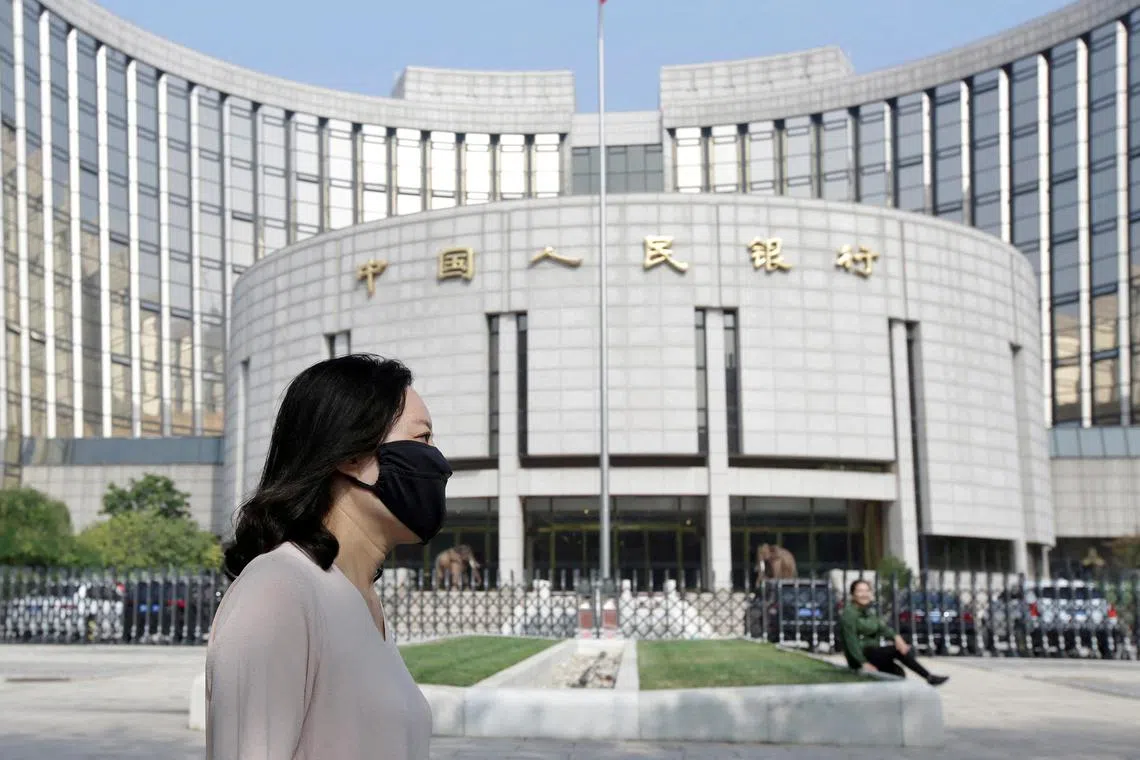China’s surging real borrowing costs to drag on growth into 2024
Sign up now: Get ST's newsletters delivered to your inbox

The People's Bank of China has trimmed policy rates twice this year.
PHOTO: REUTERS
Follow topic:
BEIJING – China’s real borrowing costs are expected to stay high in 2024 as deflation pressures linger and the central bank will likely avoid aggressive policy rate cuts, posing yet another threat to growth.
While the People’s Bank of China (PBOC) has trimmed policy rates and banks have reduced their benchmark lending rates this year to support economic activity, the nation’s real lending rates have climbed significantly.
Calculations by Bloomberg News show those rates – which are adjusted for inflation and reflect the actual cost of borrowing funds – have topped 4 per cent and may even be near 5 per cent, which would be the highest level since 2016.
That is because consumer and producer prices have fallen at a much faster pace than the average loan rate, which is largely based on changes in the benchmark rates set by the PBOC and the nation’s major lenders.
By comparison, the benchmark prime rate on one-year loans is 3.45 per cent – roughly 150 basis points lower than what real loan rates are actually estimated to be near.
“China’s real interest rates are quite high, and are still rising,” said Dr Larry Hu, head of China economics at Macquarie Group.
Along with keeping company borrowing costs elevated, he added that the high rates mean “residents are more inclined to save”.
That bodes ill for the economy, considering weak business confidence and a population that is more likely to save than spend have already been challenges this year.
The problem is there are not many signs that suggest real interest rates will see a reversal.
China’s consumer price index (CPI) in November recorded its steepest drop in three years.
The nation’s widest measure of prices, the gross domestic product deflator, was negative for two consecutive quarters this year for the first time since 2015.
Deflation is dangerous because it risks creating a downward spiral, with consumers holding off on buying anything on the expectation that prices will keep falling.
Businesses uncertain about future demand may also lower production and investment.
Several economists see pressures persisting into next year. Goldman Sachs economists forecast annual CPI to rise just 0.5 per cent in 2024, while Nomura Holdings analysts see it increasing 0.6 per cent.
Some, including economists at the Australia and New Zealand Banking Group, see prices potentially declining.
On the policymaking side, the authorities face several limitations to their ability to support the economy by making big interest rate cuts.
Top leaders have already signalled they will be more cautious about monetary easing going forward, suggesting the size of any interest rate cuts in 2024 are likely to be quite small as the focus turns to fiscal stimulus as a means of economic support.
This year, the PBOC trimmed policy rates twice – a reflection of a restrained approach to stimulus in recent years as policymakers try to preserve their room for action and avoid building up debt within risky sectors, such as property.
Cutting rates can also weigh on profit margins for banks, and those margins are already under pressure.
The outlook for the renminbi, meanwhile, remains uncertain as long as the Federal Reserve keeps rates high. The US central bank is not expected to start cutting rates until well into next year.
“Real interest rates are important, but obviously what the PBOC can do is rather limited,” said China economist Wei He of Gavekal Dragonomics.
“It’s impossible for the PBOC to match the changes in CPI for interest rates because that would mean substantial changes to rates, which is very much against its methodology.”
He said the central bank may continue to make moderate cuts to policy rates into next year if the property sector worsens – though such trims would amount to only around 10 to 20 basis points.
Any cut would require banks to also lower their deposit rates as they try to preserve their profitability.
There are other monetary policies that may be in play, too.
Ms Mo Ji of DBS Bank flagged a possible 25-basis point reduction to the reserve requirement ratio for banks in the first quarter, which would free up more long-term cash in the economy.
Eventual easing by the Fed would also likely open a bit more room for rate cuts, since a weaker dollar would mean less pressure on the renminbi.
Still, Macquarie’s Dr Hu pointed to the need for policies – particularly on the fiscal side – that would help drive inflation up.
“Macroeconomic policies – not just monetary policy – should be more proactive,” he said.
“Given the current circumstance, fiscal policy may be more important. But the end goal is the same, and that is reflation.” BLOOMBERG

